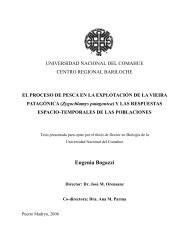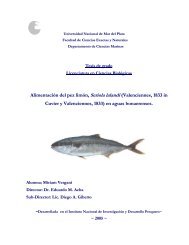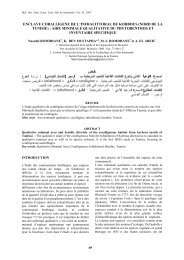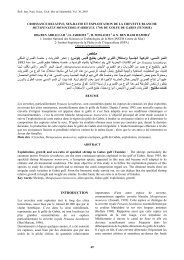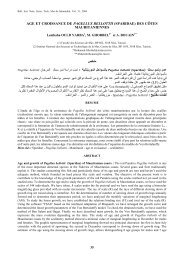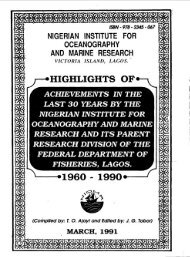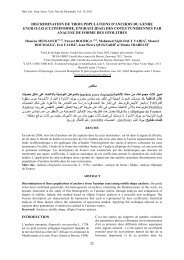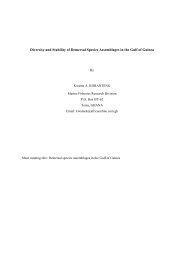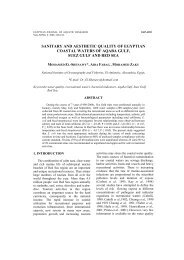Coastal vulnerability, resilience and adaptation to ... - OceanDocs
Coastal vulnerability, resilience and adaptation to ... - OceanDocs
Coastal vulnerability, resilience and adaptation to ... - OceanDocs
You also want an ePaper? Increase the reach of your titles
YUMPU automatically turns print PDFs into web optimized ePapers that Google loves.
Irrespective of the primary cause of sea-level rise (climate change, natural or human-induced<br />
subsidence, dynamic ocean effects), exposed natural coastal systems can be affected<br />
in a variety of ways. From a societal perspective, the six most important biogeophysical effects<br />
are (Klein <strong>and</strong> Nicholls, 1998):<br />
Increasing flood frequency probabilities;<br />
Erosion;<br />
Inundation;<br />
Rising water tables;<br />
Saltwater intrusion;<br />
Biological effects.<br />
These biogeophysical effects will have consequent effects on ecosystems <strong>and</strong> eventually<br />
affect socio-economic systems in the coastal zone. However, owing <strong>to</strong> the great diversity <strong>and</strong><br />
variation of natural coastal systems <strong>and</strong> <strong>to</strong> the local <strong>and</strong> regional differences in relative sealevel<br />
rise, the occurrence of <strong>and</strong> response <strong>to</strong> these effects will not be uniform around the<br />
globe. <strong>Coastal</strong> environments particularly at risk include tidal deltas <strong>and</strong> low-lying coastal<br />
plains, s<strong>and</strong>y beaches <strong>and</strong> barrier isl<strong>and</strong>s, coastal wetl<strong>and</strong>s, estuaries <strong>and</strong> lagoons <strong>and</strong> coral<br />
reefs <strong>and</strong> a<strong>to</strong>lls (Bijlsma et al., 1996). Increased coastal flooding is expected <strong>to</strong> be most severe<br />
in South <strong>and</strong> Southeast Asia, Africa, the southern Mediterranean coasts, the Caribbean<br />
<strong>and</strong> most isl<strong>and</strong>s in the Indian <strong>and</strong> Pacific Oceans (Watson et al., 1998; Nicholls et al., 1999).<br />
The effects of climate change <strong>and</strong> associated sea-level rise threaten economic sec<strong>to</strong>rs <strong>to</strong><br />
a varying extent. The potential socio-economic impacts of sea-level rise can be categorised as<br />
follows (Klein <strong>and</strong> Nicholls, 1998):<br />
Direct loss of economic, ecological, cultural <strong>and</strong> subsistence values through loss of l<strong>and</strong>,<br />
infrastructure <strong>and</strong> coastal habitats;<br />
Increased flood risk <strong>to</strong> people, l<strong>and</strong> <strong>and</strong> infrastructure <strong>and</strong> economic, ecological, cultural<br />
<strong>and</strong> subsistence values;<br />
Other impacts related <strong>to</strong> changes in water management, salinity <strong>and</strong> biological activity.<br />
Table 3 lists the most important socio-economic sec<strong>to</strong>rs in coastal zones <strong>and</strong> indicates<br />
from which of the aforementioned biogeophysical effects of climate change they are expected<br />
<strong>to</strong> suffer direct impacts. Indirect impacts, for example impacts on human health resulting<br />
from deteriorating water quality, are also likely <strong>to</strong> be important <strong>to</strong> many sec<strong>to</strong>rs, but<br />
these are not shown in Table 3.<br />
Sec<strong>to</strong>r<br />
Biogeophysical effect<br />
Flood<br />
Water Saltwater Biological<br />
Erosion Inundation<br />
frequency<br />
table rise intrusion effects<br />
Water resources <br />
Agriculture <br />
Human health <br />
Fisheries <br />
Tourism <br />
Human settlements <br />
Table 3 — Qualitative overview of direct socio-economic impacts of climate change on a<br />
number of sec<strong>to</strong>rs in coastal zones (Klein <strong>and</strong> Nicholls, 1998).<br />
Changes in extreme events, whilst still uncertain, can have important consequences for<br />
coastal zones. For example, cyclones in the Bay of Bengal <strong>and</strong> hurricanes in the Caribbean<br />
have already caused serious economic disruption, damage <strong>to</strong> infrastructure <strong>and</strong> loss of human<br />
life, independent of global climate change. As stated, however, the mechanisms that determine<br />
the occurrence of such events, as well as their patterns, are poorly unders<strong>to</strong>od.<br />
In the 1990s, a large <strong>and</strong> concerted effort was made <strong>to</strong> assess the implications of sealevel<br />
rise on coastal countries. Studies have been carried out on local, national <strong>and</strong> regional<br />
scales (e.g., Jeftić et al., 1992, 1996; Tooley <strong>and</strong> Jelgersma, 1992; Ehler, 1993; McLean <strong>and</strong><br />
11






